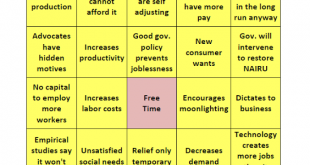This isn’t actually news, but it’s news to me, and it’s something you need to know. Greg LeRoy sent me an article by James Meek in London Review of Books (20 April 2017) that he’d been sent by a friend, documenting more EU-permitted job piracy by Poland that preceded the case I discuss at length in my book, Investment Incentives and the Global Competition for Capital. There, I criticized the European Commission’s Directorate-General for Competition for...
Read More »Democrats Win One
The US Federal Government isn’t shutting down. Also it seems that Republicans almost totally caved to Democrats in the deal Kelsey Snell at the Washington Post Schumer and House Minority Leader Nancy Pelosi (D-Calif.) boasted that they were able to force Republicans to withdraw more than 160 unrelated policy measures, known as riders, including those that would have cut environmental funding and scaled back financial regulations for Wall Street. Democrats...
Read More »The new Robert’s Supreme Court
Linda Greenhouse of the NYT comments: A Supreme Court quiz: Who offered this paean to judicial restraint: “If it is not necessary to decide more to a case, then in my view it is necessary not to decide more to a case”? … That was nearly 11 years ago, only eight months into his tenure. It was before Citizens United erased limits on corporate spending in politics, before Shelby County v. Holder eviscerated the Voting Rights Act, before Chief Justice Roberts...
Read More »Gibberish
by Sandwichman Gibberish Repeat after me: The world is not a zero-sum game. Technology often creates more jobs than it destroys. The number of jobs in the economy depends on how much people are spending and investing. High-skilled tech workers grow the economic pie by boosting productivity, encouraging more investment and increasing entrepreneurship. Economists call this “the lump of labor” fallacy. Jennifer Rubin, WaPo Trump and right-wingers who have never...
Read More »Waldmann Vs Waldman (finally)
I am generally very very impressed by Paul Waldman at the Plum line blog (for one thing I admire the lack of Ego he demonstrates by writing for a blog subtitled “Greg Sargent’s take from a liberal perspective). Waldman is reliably brilliant (so is Sargent). Now finally I find something he wrote with which I disagree. In the generally excellent “President Trump Appoints Tax Fairy to Key Economic Post” Waldman wrote ” The point isn’t that tax increases help...
Read More »Angry Bear 2017-04-17 06:20:39
It was actually quite amusing to see an article in my provincial newspaper a while back where two sides were arguing about a reduction in the work week, and you could play bingo with the excuses the anti-side used. There wasn’t an original idea in the whole article, as the pro-side was almost apologizing and got one paragraph of the six on offer. – “Salty,” comment at AngryBear. See also “Boundless Thirst for Surplus Labor”...
Read More »The Simpsons on Immigration
A post from 2006 on immigration by Kash Mansori seems timely… The Simpsons on Immigration Kash | March 28, 2006 1:31 pm Simpsons aficionados among you already know that the Simpsons addressed the issue of immigration back in 1996, in the episode “Much Apu About Nothing”. Here’s a summary of the beginning of the episode, thanks to Wikipedia (Btw, I never would have guessed that Wikipedia contains entries on individual Simpsons episodes…) On an ordinary day, a...
Read More »High Cost of Our Finance Sectors
Via Truthout Published on Mar 23, 2017 In the March 2017 Taxcast: the high price we’re paying for our finance sectors – we look at staggering statistics showing how the US finance sector is a net drag on their economy. [embedded content]Featuring: John Christensen and Alex Cobham of the Tax Justice Network, and Professor of Economics Gerald Epstein of the University of Masachusetts Amhurst. Produced and presented by Naomi Fowler for the Tax Justice Network....
Read More »The Boundless Thirst for Surplus-Labor
September 22, 1956 November 7, 1960 QUESTION. This is from Mr. White, Warren, Mich. What is your stand on the 32-hour workweek? Vice President NIXON: Well, the 32-hour workweek just isn’t a possibility at the present time. I made a speech back in the 1956 campaign when I indicated that as we went into the period of automation, that it was inevitable that the workweek was going to be reduced, that we could look forward to the time in America when we might...
Read More »To me the common assertion about health care reform reform and tax reform makes no sens
Various people have argued that Republicans decided to repeal and (very partially) replace Obamacare before moving on to tax reform, because Obamacare repeal (aka the American Health Care Act aka AHCA) would make it easier to permanently cut tax rates. To me this makes less than zero sense. The argument is that, since AHCA includes tax cuts, tax reform would start from a lower base, so it would be easier to write a tax reform bill which doesn’t add to the...
Read More » Heterodox
Heterodox


